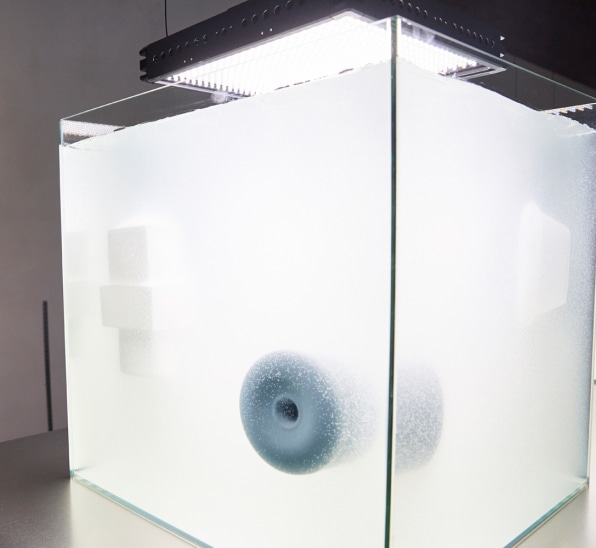MIT provides a place for brilliant minds to develop in each other’s company and, not surprisingly, fascinating developments in design and technology are produced there as a result. One of the many internal organizations that create this atmosphere of experimentation and innovation is the Self-Assembly Lab. The Self-Assembly Lab is a research lab dedicated to the creation of self-assembly and programmable material technologies. Their latest creation, rapid liquid printing, is generating a great deal of interest as it could potentially create a tectonic shift in the way that 3D printing of objects is conceived and produced.

The creation of objects using Rapid Liquid Prototyping occurs in a gel suspension. Photo courtesy of the Patrick Parrish Gallery.
Rapid Liquid Printing (RLP) differs from traditional 3D printing in that rather than build an object up by laying down layer after layer of material, the object is created by drawing in a liquid gel suspension that works to support the object as it is robotically drawn. This process is not only faster than traditional 3D printing but allows for the creation objects with much greater degrees of intricacy. The Self-Assembly Lab team make the case for their new and improved 3D printing process as follows:
“3D printing hasn’t taken off as a mainstream manufacturing process for three main reasons: 1) it’s too slow compared to conventional processes like injection molding, casting, milling, etc. 2) it’s limited by scale – although it’s good for creating small components, it’s not possible to produce large scale objects 3) the materials are typically low-quality compared to industrial materials. Rapid Liquid Printing addresses all of these limitations: it is incredibly fast (producing structures in a matter of minutes), designed for large scale products (you can print an entire piece of furniture) and uses real-world, industrial-grade materials.”

Inflatable liquid-printed, white silicone rubber wall lamp designed by the Self-Assembly Lab, MIT and Christophe Guberan.
Photo courtesy of the Patrick Parrish Gallery.
The most recent products using this technology are part of a collection created by Swiss designer Christoph Guberan and the Self-Assembly Lab and are on display, and available for purchase at the Patrick Parrish Gallery in New York. The exhibition, entitled Liquid to Air: Pneumatic Objects, is on display until August 26, and is comprised of objects that are printed from a stretchy silicone material that can be inflated, thereby taking advantage of what has typically been a very difficult material to utilize with 3D printers. The potential these objects hold to be manipulated and to shift after printing is the fourth dimension that has been added to the process, rather than an object as an end, these objects continue to develop after they are produced. Guberan, who has been collaborating with the lab since 2014, explained the interest in working with such object:
“People often ask me where the interest lies for a product designer, or if I identify more as a product designer or material researcher. For me, I see the lab and the people working there as simply having a new way of producing objects. It’s like working with future artisans, the artisans of tomorrow. As a designer, people usually expect that we turn out one design, a perfect final masterpiece—but with this technology, the outcome is much more flexible, less definite. Once it’s printed, the object has the ability to take on another life of its own.”

Liquid-printed, clear silicone rubber vessel designed by the Self-Assembly Lab, MIT and Christophe Guberan.
Photo courtesy of the Patrick Parrish Gallery.
The objects created for this exhibition have been fitted with LED lights or have been interpreted as vases and are available to the public for prices ranging from $95 to $3,200 depending on the size and complexity of the object. The potential presented by these kinds of objects is far greater than just the production of decorative objects and well beyond the cinematic wow factor of advanced technology. The researchers at the Self-Assembly Lab see the potential for such flexibly evolving objects in everything from the future of airbags to the creation of inflatable emergency shelters. It’s the ability of these objects to continue to evolve and perform after they are created that makes them so particularly interesting, the smarter the materials get, the more our objects can do for us, becoming almost partners in problem-solving rather than just a tool to be wielded.
What do you think of this news? Let us know your thoughts; join the discussion of this and other 3D printing topics at 3DPrintBoard.com.
Subscribe to Our Email Newsletter
Stay up-to-date on all the latest news from the 3D printing industry and receive information and offers from third party vendors.
Print Services
Upload your 3D Models and get them printed quickly and efficiently.
You May Also Like
U.S. Navy Lab Uses 3D Printing to Reduce Tooling Lead Time By Over 90%
The F-35 Lightning II Joint Program Office (JPO), responsible for life-cycle management of the key fifth-generation joint strike fighter (JSF) system used by the U.S., its allies, and its partners,...
Etsy Design Rule Change Reduces Selection of 3D Printed Goods
Online marketplace Etsy has implemented a rule change requiring all 3D printed goods on the site to be original designs. The update to the site’s Creativity Standards states, ¨Items produced using...
Honeywell Qualifies 6K Additive’s Nickel 718 for 3D Printed Aerospace & Defense Parts
6K Additive is renowned for manufacturing sustainable additive manufacturing (AM) powder, and offers a wide portfolio of premium metal and alloy powders that include titanium, copper, stainless steel, and nickel,...
MetalWorm Sells WAAM Systems to Research Institutes in Brazil and Malaysia
Turkish WAAM firm MetalWorm has sold a system in Malaysia and another in Brazil. This is an excellent example of a few emerging trends in additive. Firstly, WAAM was experimented...

































